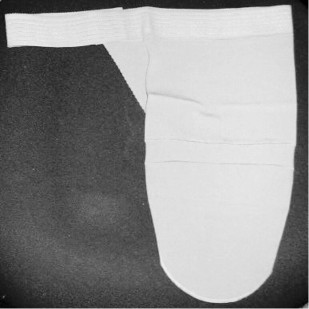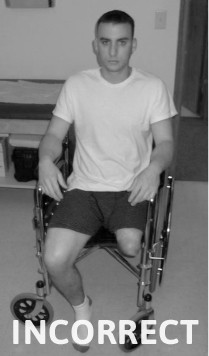After the amputation there are several ways of dressing the residual limb. The most common way of dressing the limb is with the use of simple gauze dressings. This is typically done in the operative room by your physician immediately following surgery. These dressings will then be changed periodically.
IPOP Prosthesis
There are more aggressive approaches to post operative care that may include the use of a rigid dressing or what is termed an Immediate Post-Operative Prosthesis or IPOP. An IPOP is an immediate postoperative prosthesis that is used as an early form of prosthetic intervention.

The benefit of being fit with an IPOP prosthesis is early ambulation if allowed by your physician. An IPOP prosthesis is also said to help with phantom limb sensation, because you can see that there is a leg, or in this sense, a prosthesis attached.
IPOP prostheses also protect the residual limb from being injured. Many times, a patient will wake up in the middle of the night to use the restroom, and forget that their limb has been amputated. When they get out of bed and try to stand on both limbs, they fall down and re-injure thesurgery site.
An IPOP prosthesis will protect the end of the residual limb should this occur. There are many different types of postoperative care and your physician will help you choose which the best is for you.
Shrinkers
At some point after your surgery, your healthcare providers will discuss several things with you including the use of shrinkers,desensitization, positioning, contracture prevention, exercise, phantom sensation and phantom pain. To manage post-operative edema, you may be prescribed a shrinker or ace wrap as a means of compression therapy.

Shrinkers are elastic garments that are simply pulled on or wrapped around the limb. They are typically used when the suture line is reasonably healed. Until that time, an ace wrap may be used. Both methods help to expel excess fluid that remains inside the limb. This helps to prepare you to wear a prosthesis by providing an appropriate limb shape.
Desensitization
Desensitization is important to prepare your residual limb for the forces that will soon be applied with a prosthesis.
The most common and easiest way to desensitize the limb is to gently massage the entire area several times a day; this will decrease the skins sensitivity. There are several different techniques, you should speak with your physical therapist about which one is best for you.
Positioning
Positioning is extremely vital to help prevent contractures that can cause problems when fitting a prosthesis.
If you are going to be sitting in a wheelchair you should always sit up straight, keep equal weight on both hips and try not to slouch. Avoiding any prolonged periods of sitting is best if possible.

If you sit with your hips bent (flexed) for a long period of time, the limb may develop a contracture and prolong the necessary therapy. This will negatively effect your rehabilitation. Contractures can cause you to be uncomfortable in your prosthesis and/or effect how well you are able to walk. If a severe enough contracture occurs, this will limit your prosthetic options and candidacy.
Proper positioning can be achieved with the use of a pillow while lying face down in bed. If you are lying on your back, avoid placing any pillows under your limb. One simple position that can greatly increase flexibility is to lay on your stomach and stretch the limb backward.
When lying in bed remember to keep your legs together and try to avoid any type of rotation. Keeping these strategies in mind can help prevent unwanted contractures.

Phantom Limb Sensation
Almost every amputee experiences the sensation that the amputated limb is still present. 1 These feeling can occur due to a variety of factors including pressure or even weather changes. These sensations may disappear quickly or in some cases can remain for quite sometime. Phantom sensations are different for everyone and should not present any problems to prosthetic fittings.
Phantom Limb Pain
In addition to phantom sensations, some people experience various types of phantom pain in the amputated limb. 1 The causes of these phantom pains remain unknown but there are treatments available to help manage symptoms. If you experience phantom pain you should contact your physician or nurse so that they can recommend the appropriate treatment.
Exercise
After an amputation it is common to feel
weak and unsteady. This is why it is important to begin stretching and
exercise as soon as you are able.

There are many different types of exercises; some can be done while lying in bed, some standing, some sitting, and more. At times, home exercise is important and at other times you may need to visit your physical therapy clinic. Your physical therapist will be able to explain and demonstrate these and/or other exercises that are appropriate and beneficial for you.
